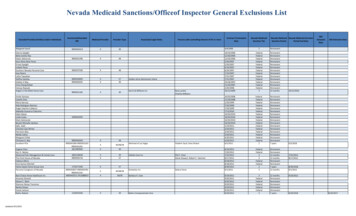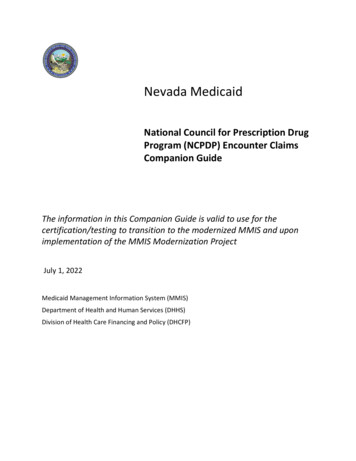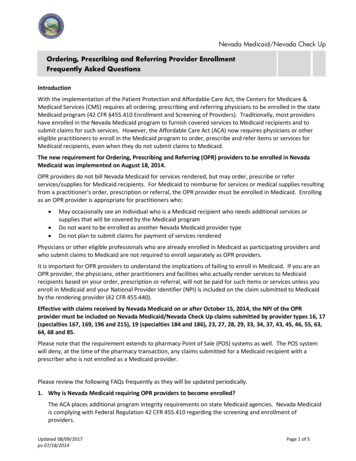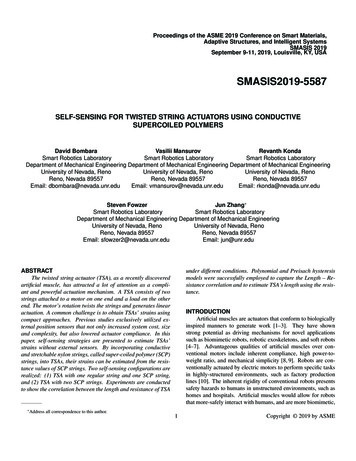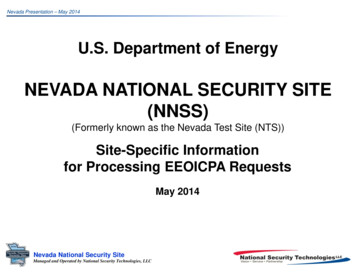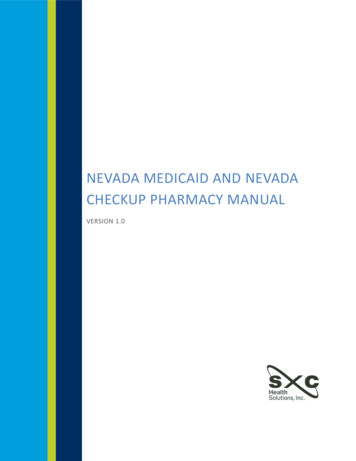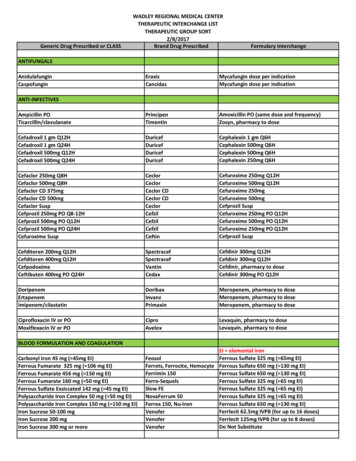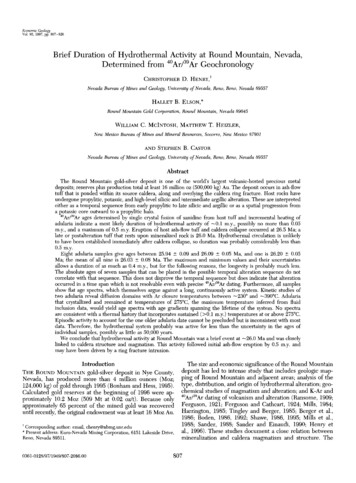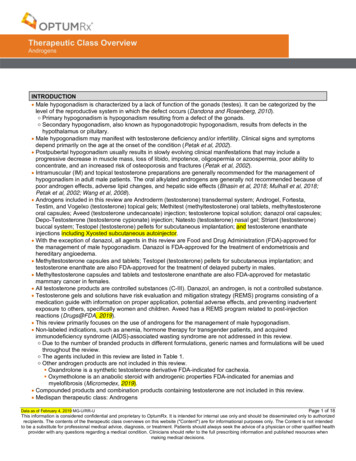
Transcription
Therapeutic Class OverviewAndrogensINTRODUCTION Male hypogonadism is characterized by a lack of function of the gonads (testes). It can be categorized by thelevel of the reproductive system in which the defect occurs (Dandona and Rosenberg, 2010). Primary hypogonadism is hypogonadism resulting from a defect of the gonads. Secondary hypogonadism, also known as hypogonadotropic hypogonadism, results from defects in thehypothalamus or pituitary. Male hypogonadism may manifest with testosterone deficiency and/or infertility. Clinical signs and symptomsdepend primarily on the age at the onset of the condition (Petak et al, 2002). Postpubertal hypogonadism usually results in slowly evolving clinical manifestations that may include aprogressive decrease in muscle mass, loss of libido, impotence, oligospermia or azoospermia, poor ability toconcentrate, and an increased risk of osteoporosis and fractures (Petak et al, 2002). Intramuscular (IM) and topical testosterone preparations are generally recommended for the management ofhypogonadism in adult male patients. The oral alkylated androgens are generally not recommended because ofpoor androgen effects, adverse lipid changes, and hepatic side effects (Bhasin et al, 2018; Mulhall et al, 2018;Petak et al, 2002; Wang et al, 2008). Androgens included in this review are Androderm (testosterone) transdermal system; Androgel, Fortesta,Testim, and Vogelxo (testosterone) topical gels; Methitest (methyltestosterone) oral tablets, methyltestosteroneoral capsules; Aveed (testosterone undecanoate) injection; testosterone topical solution; danazol oral capsules;Depo-Testosterone (testosterone cypionate) injection; Natesto (testosterone) nasal gel; Striant (testosterone)buccal system; Testopel (testosterone) pellets for subcutaneous implantation; and testosterone enanthateinjections including Xyosted subcutaneous autoinjector. With the exception of danazol, all agents in this review are Food and Drug Administration (FDA)-approved forthe management of male hypogonadism. Danazol is FDA-approved for the treatment of endometriosis andhereditary angioedema. Methyltestosterone capsules and tablets; Testopel (testosterone) pellets for subcutaneous implantation; andtestosterone enanthate are also FDA-approved for the treatment of delayed puberty in males. Methyltestosterone capsules and tablets and testosterone enanthate are also FDA-approved for metastaticmammary cancer in females. All testosterone products are controlled substances (C-III). Danazol, an androgen, is not a controlled substance. Testosterone gels and solutions have risk evaluation and mitigation strategy (REMS) programs consisting of amedication guide with information on proper application, potential adverse effects, and preventing inadvertentexposure to others, specifically women and children. Aveed has a REMS program related to post-injectionreactions (Drugs@FDA, 2019). This review primarily focuses on the use of androgens for the management of male hypogonadism. Non-labeled indications, such as anemia, hormone therapy for transgender patients, and acquiredimmunodeficiency syndrome (AIDS)-associated wasting syndrome are not addressed in this review. Due to the number of branded products in different formulations, generic names and formulations will be usedthroughout the review. The agents included in this review are listed in Table 1. Other androgen products are not included in this review. Oxandrolone is a synthetic testosterone derivative FDA-indicated for cachexia. Oxymetholone is an anabolic steroid with androgenic properties FDA-indicated for anemias andmyelofibrosis (Micromedex, 2019). Compounded products and combination products containing testosterone are not included in this review. Medispan therapeutic class: AndrogensPage 1 of 18This information is considered confidential and proprietary to OptumRx. It is intended for internal use only and should be disseminated only to authorizedrecipients. The contents of the therapeutic class overviews on this website ("Content") are for informational purposes only. The Content is not intendedto be a substitute for professional medical advice, diagnosis, or treatment. Patients should always seek the advice of a physician or other qualified healthprovider with any questions regarding a medical condition. Clinicians should refer to the full prescribing information and published resources whenmaking medical decisions.Data as of February 4, 2019 MG-U/RR-U
Table 1. Medications Included Within Class ReviewDrugAndroderm(testosterone transdermal system) patchAndrogel, Fortesta, Testim, Vogelxo (testosterone) topical gelMethitest (methyltestosterone) tablets, methyltestosteronecapsulesAveed (testosterone undecanoate)testosterone topical solutiondanazolDepo-Testosterone (testosterone cypionate)Natesto (testosterone) nasal gelStriant (testosterone) buccal systemTestopel (testosterone) pellets for subcutaneous implantationtestosterone enanthateXyosted (testosterone enanthate) autoinjector forsubcutaneous injectionGeneric Availability *-/ § † ‡-*A-B rated generics are available for Androgel 1% and 1.62% gel. An authorized generic is also available for Androgel 1.62%, Testim,Vogelxo, and Fortesta. In addition, the FDA has determined that Testim and Vogelxo are therapeutically equivalent. Branded product, Axiron, is no longer manufactured, but it is still available as a generic.†Branded product, Danocrine, is no longer manufactured, but it is still available as a generic.‡Branded product, Delatestryl, is no longer manufactured, but it is still available as a generic.§Branded products, Android and Testred (methyltestosterone capsules), are no longer manufactured, but are still available as generics.Methitest is only available as a branded product.(Drugs@FDA, 2019; Orange Book: Approved Drug Products with Therapeutic Equivalence Evaluations, 2019)Data as of February 4, 2019 MG-U/RR-UPage 2 of 18This information is considered confidential and proprietary to OptumRx.It is intended for internal use only and should be disseminated only to authorized recipients.
INDICATIONStestosteronenasal etopical testosteroneundecanoate* mitations of Use:Safety and efficacy in men with “age-relatedhypogonadism” have not been establishedSafety in males under the age of 18 years has notbeen establishedTopical testosterone products may have differentdoses, strengths, or application instructions thatmay result in different systemic exposuretestosteronebuccalReplacement therapy in males for deficiency orabsence of endogenous testosterone due to primaryhypogonadism (congenital or acquired)Replacement therapy in males for deficiency orabsence of endogenous testosterone due tohypogonadotropic hypogonadism (congenital oracquired)Stimulation of puberty in carefully selected maleswith clearly delayed puberty that is not secondaryto a pathological disorderTreatment of metastatic mammary cancer inwomen with inoperable metastatic (skeletal)mammary cancer who are 1 to 5 yearspostmenopausalTreatment of endometriosis amenable to hormonal managementPrevention of attacks of angioedema of all types methyltestosteronedanazolTable 2. Food and Drug Administration Approved IndicationsIndication Data as of February 4, 2019 MG-U/RR-U †Page 3 of 18This information is considered confidential and proprietary to OptumRx.It is intended for internal use only and should be disseminated only to authorized recipients.
*Aveed should only be used in patients who require testosterone replacement therapy and in whom the benefits of the product outweigh the serious risks of pulmonary oil microembolism(POME) and anaphylaxis.†Androgel, Testim, and Vogelxo only(Prescribing information: Androderm, 2018; Androgel 1%, 2016; Androgel 1.62%, 2016; Android, 2015; Aveed, 2018; danazol, 2018; Depo-Testosterone,2018; Fortesta, 2017; Methitest, 2016; Natesto, 2016; Striant, 2016; Testim, 2018; Testopel, 2018; testosterone enanthate, 2017; testosterone topical solution,2018; Testred, 2015; Vogelxo, 2017; Xyosted 2018) Information on indications, mechanism of action, pharmacokinetics, dosing, and safety has been obtained from the prescribing information forthe individual products, except where noted otherwise.Data as of February 4, 2019 MG-U/RR-UPage 4 of 18This information is considered confidential and proprietary to OptumRx.It is intended for internal use only and should be disseminated only to authorized recipients.
CLINICAL EFFICACY SUMMARY Male Hypogonadism In clinical studies, testosterone transdermal system (Androderm), topical gel (Androgel, Fortesta,Testim), and topical solution have been shown to increase serum testosterone and lean body mass,decrease body fat, and improve sexual function in men with hypogonadism. Increases in hemoglobin,hematocrit, and prostate specific antigen (PSA) were observed (Brock et al, 2016, Dobs et al, 2012;Grober et al, 2008; McNicholas et al, 2003; Roy et al, 2017; Steidle et al, 2003; Swerdloff et al, 2000;Wang et al, 2000; Wang et al, 2004; Wang et al, 2011). A network meta-analysis of 87 randomized and 51 non-randomized studies concluded thattestosterone replacement therapies, as a class, improved quality of life, libido, depression, and sexualfunction as compared to placebo (Elliott et al, 2017). Additionally, individual product comparisonswere also made. Most endpoints did not reveal significant differences between products, but the 1%testosterone gel was significantly better than the patch for improvement in libido. A 36-month extension study demonstrated that long-term treatment with testosterone topical gel(Androgel) maintained increased levels of serum testosterone as well as improvements in sexualfunction, positive mood, and body composition. A gradual but significant improvement in hip andspine bone mineral density was also observed. Increases in hemoglobin and hematocrit plateaued at12 months, and clinically insignificant increases in high-density lipoprotein cholesterol, serumcreatinine, and total bilirubin were seen. Serum levels of PSA showed no further significant increasespast 6 months of treatment. Treatment-emergent adverse events included application site reactions,acne, and gynecomastia (Wang et al, 2004). Head-to-head studies comparing testosterone topical gel (Androgel, Testim) to testosterone patch(Androderm) have shown greater improvement in serum testosterone levels, lean body mass, andsexual function as well as fewer adverse events with testosterone gel compared to testosteronepatches in men with hypogonadism (McNicholas et al, 2003; Steidle et al, 2003; Swerdloff et al, 2000;Wang et al, 2000). In an open-label study, hypogonadal men on testosterone replacement therapy with suboptimalresponse underwent brand substitution and switched between Androgel and Testim. More patientswho switched from Androgel to Testim experienced improvements in libido, erectile function, andenergy levels compared to those who switched from Testim to Androgel. Changing from Testim toAndrogel eliminated or minimized unwanted adverse effects (Grober et al, 2008). Testosterone buccal system (Striant) was compared to testosterone transdermal system ortestosterone topical gel in 2 randomized controlled studies with hypogonadal men. Testosteronebuccal system was shown to lead to serum testosterone levels within normal ranges that were similarto testosterone topical gel and transdermal system (Dobs et al, 2004; Korbonits et al, 2004). A double-blind, randomized controlled trial showed that testosterone cypionate improved grip strengthand increased hemoglobin compared to placebo in hypogonadal men (Sih et al, 1997). An open-label trial comparing 4 different dosing regimens of testosterone enanthate in men withprimary hypogonadism showed that testosterone enanthate 200 mg every 2 weeks and 300 mg every3 weeks were most effective in suppressing serum luteinizing hormone to normal, while 100 mg everyweek and 200 mg every 2 weeks were effective in suppressing follicle-stimulating hormone to normal(Snyder et al, 1980). In a small, open-label study, methyltestosterone was associated with improvement in sexual functionin men with profound testosterone deficiency but no noticeable changes in levels of energy, mood, orfeeling of well-being (Morales et al, 1994). Aveed was approved via the 505(b)(2) pathway. The primary clinical trial submitted for its approvalwas a Phase 3, multi-center, open-label, 84-week, pharmacokinetic and safety study of testosteroneundecanoate in hypogonadal men. Adult males with primary or secondary hypogonadism andtestosterone levels 300 ng/dL were given 750 mg of testosterone undecanoate IM at baseline, 4weeks, and every 10 weeks thereafter for a total of 9 injections (N 130). At week 14 (after the thirddose), the percentage of the 117 patients still enrolled with an average serum total testosteroneconcentration within the normal range (300 to 1000 ng/dL) was 94% (95% confidence interval [CI],89.7 to 98.3%). The percentage of patients with a maximum total testosterone concentration 1500ng/dL was 92%. The authors concluded that testosterone undecanoate 750 mg achieved sustained,consistent serum testosterone in the normal range during a 10-week dosing interval (Morgentaler etData as of February 4, 2019 MG-U/RR-UPage 5 of 18This information is considered confidential and proprietary to OptumRx.It is intended for internal use only and should be disseminated only to authorized recipients.
al, 2008). Additional trials of testosterone undecanoate have been completed, but published resultsare limited. In 1 trial, the dose was not specified, but testosterone undecanoate was demonstrated tobe effective in a large number of patients (Zitzmann et al, 2013). One study demonstratedimprovement in scores on the Aging Male Symptoms (AMS) scale, which is 1 measurement of healthrelated quality of life, when testosterone undecanoate 1000 mg was used (Ho et al, 2012). One study with a 6-year follow up measured mortality in patients with type 2 diabetes (N 581) withlow vs. normal testosterone levels (some of whom were treated with testosterone gel or testosteroneundecanoate to maintain normal levels). The authors found that patients with low testosterone hadhigher mortality rates than those with normal levels (17.2 vs. 9%; p 0.003) (Muraleedharan et al,2013). The Testosterone Trials were a coordinated set of clinical trials designed to determine whethertestosterone would benefit men with age-related low testosterone levels. Initial results from 3 of the 7trials have been published (Snyder et al, 2016). Each participant was enrolled in 1 or more of the 3trials (the Sexual Function Trial, the Physical Function Trial, and the Vitality Trial). In addition to theresults for the individual trials, the primary efficacy outcome of each trial was assessed amongparticipants across all 3 trials. Patients (N 790) aged 65 years with serum testosterone levels 275 ng/dL were assigned to receive either testosterone gel (Androgel 1%) or placebo for 1 year. Sexual function: Participants taking testosterone experienced an increase in sexual activity asassessed by question 4 on the Psychosexual Daily Questionnaire (PDQ-Q4) in both the SexualFunction Trial (mean difference, 0.58; p 0.001) and among all trial participants (mean difference,0.62; p 0.001). Testosterone treatment was also associated with increased sexual desire andimproved erectile function. Physical function: Among patients enrolled in the Physical Function Trial, testosterone was notassociated with a significant difference vs. placebo in the percentage of patients achieving a 50meter increase in the 6-minute walking distance (6MWD) (odds ratio [OR], 1.42; p 0.2); there wasalso no difference in the mean change from baseline in 6MWD. There was no significant differencein the percentage of patients with an increase of 8 points in the physical function domain (PF-10)of the Medical Outcomes Study 36-item Short-Form Health Survey (SF-36); however, there was asignificant difference in the mean change from baseline in PF-10 score (mean difference, 2.75points; p 0.03). When results from the 3 trials combined were considered, there was a significantdifference in the percentage of patients with a 50 meter increase in 6MWD (OR, 1.76; p 0.003)as well as each of the secondary physical function endpoints. Vitality: Among patients in the Vitality Trial, testosterone was not associated with a significantdifference vs. placebo in vitality as determined by an increase of 4 points on the FunctionalAssessment of Chronic Illness Therapy (FACIT)-Fatigue scale (OR, 1.23; p 0.3). However,improvements were observed on several secondary endpoints, including the SF-36 vitality score(mean difference, 2.41 points; p 0.03), the positive and negative affect schedule (PANAS)positive affect score (mean difference, 0.47 points; p 0.04), the PANAS negative affect score(mean difference, -0.49 points; p 0.001), and the patient health questionnaire (PHQ-9)depression score (mean difference, -0.72 points; p 0.004). There was no significant difference inthe percentage of patients with an increase of 4 points on the FACIT-Fatigue score when resultsof the 3 trials combined were considered (OR, 1.23; p 0.22); however, the effect of testosteroneon the mean change from baseline in the FACIT-Fatigue score was significant (mean difference,1.27; p 0.006). Safety: No significant differences between groups were demonstrated in cardiac adverse events.Seven men in each group had major adverse cardiovascular events (myocardial infarction, stroke,or death from cardiovascular causes) during the treatment period, and 2 patients in thetestosterone group and 9 in the placebo group had major adverse cardiovascular events in thesubsequent year. More patients assigned to testosterone had an increase in PSA of 1 ng/dL (23vs 8); 1 man (in the testosterone group) was diagnosed with prostate cancer during the treatmentperiod, and 2 patients in the testosterone group and 1 in the placebo group were diagnosed in thesubsequent year. A hemoglobin level 17.5 g/dL was observed in 7 men in the testosterone groupand none in the placebo group. No difference was seen in the international prostate symptomscore (IPSS).Data as of February 4, 2019 MG-U/RR-UPage 6 of 18This information is considered confidential and proprietary to OptumRx.It is intended for internal use only and should be disseminated only to authorized recipients.
Conclusions: Testosterone supplementation had small-to-moderate effects on all measures ofsexual function and some measures of physical function, mood, and depressive symptoms.Although cardiovascular events were not increased with testosterone supplementation, the trialwas not large enough to exclude smaller increases in risk. In addition, safety with respect toprostate cancer and urinary symptoms cannot be generalized because men with a high risk ofprostate cancer and men with moderately severe urinary symptoms were excluded from the trial. Separate publications reported additional results from the Testosterone Trials. The CognitiveFunction Trial included a subgroup of men (n 493) with age-associated memory impairment(Resnick et al, 2017). Testosterone replacement did not improve delayed paragraph recall in thesepatients at 6 and 12 months (adjusted estimated difference, -0.07; p 0.88). In the CardiovascularTrial (n 170) coronary computed tomographic angiography (CCTA) was used to determine whethertestosterone slowed the progression of noncalcified coronary artery plaque. It was found thattestosterone treatment was associated with a significantly greater increase in noncalcified plaquevolume after 12 months of treatment compared with placebo: estimated difference, 41 mm3; p 0.003(Budoff et al, 2017). The Bone Trial (n 211) found testosterone treatment to significantly improvemean spine and hip volumetric bone mass density compared with placebo (Snyder et al, 2017). A randomized, double-blind, placebo-controlled trial found that once daily application of testosterone2% solution for 12 weeks restored normal testosterone levels, and led to significant improvements insex drive in men with hypogonadism; improvements in energy levels were variable (Brock et al,2016). Meta-analyses have evaluated the potential adverse effects associated with testosterone use. Onefound that patients treated with testosterone had higher rates of cardiovascular-related events thanpatients treated with placebo (Xu et al, 2013). However, another meta-analysis that included bothrandomized controlled and epidemiological studies found no difference in the risk of majorcardiovascular events between testosterone and placebo (Corona et al, 2018). Calof and colleaguesfound that patients treated with testosterone had a greater rate of prostate events and elevatedhematocrit compared to patients treated with placebo (Calof et al, 2005). The efficacy and safety of Xyosted were evaluated in an open-label, single-arm, dose-blinded, 52week study in 150 men with hypogonadism (Kaminetsky et al, 2018). Patients were started on 75 mgXyosted self-administered on a weekly basis with dose adjustments made at week 7 based on totaltestosterone trough concentrations. Results revealed that 92.7% of subjects achieved an averagetotal testosterone concentration of 300 to 1100 ng/dL at week 12 with a maximum serumconcentration of 1500 ng/dL achieved by 91.3% of patients and 0 patients with levels 1800 ng/dL.At week 52, the mean testosterone trough concentration was 487.2 153.33 ng/dL. The mostfrequently reported treatment-related adverse events were increases in hematocrit, hypertension, andPSA; no serious treatment-related adverse events were reported. Delayed puberty and delayed growth Testosterone products, including testosterone enanthate and methyltestosterone have been studiedin the treatment of delayed growth and puberty in adolescent males. These products havedemonstrated increased growth (weight and height) in the time periods studied, but it is difficult todetermine the long-term effects on bone health as the trials had relatively limited durations and studypopulations (Kaplan et al, 1973; Rosenfeld et al, 1982; Soliman et al, 1995). Endometriosis Danazol is used for the palliative treatment of endometriosis in patients in whom alternative hormonaltherapy (eg, estrogen and progestin or testosterone) is ineffective, intolerable or contraindicated(Micromedex, 2019). A meta-analysis of 5 placebo-controlled trials concluded that danazol waseffective in relieving pain and improving laparoscopic scores in women with endometriosis; however,its use was limited by the occurrence of androgenic adverse effects (Selak et al, 2007). Hereditary angioedema Studies have reported that danazol was beneficial in reducing the frequency and severity of acuteattacks and increasing the serum levels of C1 esterase inhibitor and the fourth component ofcomplement (Bork et al, 2008; Gelfand et al, 1976). Treatment of metastatic mammary cancer Studies on the use of methyltestosterone have not been included in the detailed review. Endocrinetherapy (including androgens) may be used for metastatic breast cancer in post-menopausal women.Data as of February 4, 2019 MG-U/RR-UPage 7 of 18This information is considered confidential and proprietary to OptumRx.It is intended for internal use only and should be disseminated only to authorized recipients.
Androgens are rarely used (often considered last-line therapy) in the treatment of metastatic breastcancer. While response rates may be reasonable, adverse effects, including virilization, edema, andjaundice, limit their clinical applicability compared to other treatment options (Ma, 2018).CLINICAL GUIDELINES Male hypogonadism The American Urological Association recommends the use of testosterone replacement therapy inmen with testosterone deficiency but provides no specific guidance other than to avoidmethyltestosterone (Mulhall et al, 2018). The European Association of Urology (EAU) recommendsthat choice of therapy should be based on risk vs benefit decisions between the provider and patientand states that short-acting therapies may be preferred when initiating therapy (Dohle et al, 2018).The Endocrine Society recommends all testosterone products in appropriate doses, with theexceptions of danazol and methyltestosterone (Bhasin et al, 2018). A joint statement by theInternational Society of Andrology (ISA), International Society for the Study of the Aging Male(ISSAM), EAU, European Academy of Andrology (EAA), and American Society of Andrology (ASA)agrees that decisions should be made based on patient and prescriber preference and tolerability, butstates that methyltestosterone should be avoided due to potential liver toxicity (Wang et al, 2008).The American Association of Clinical Endocrinologists (AACE) also agrees with the recommendationto avoid methyltestosterone (Petak et al, 2002). Endometriosis Both the American Society for Reproductive Medicine (ASRM) and American Congress ofObstetricians and Gynecologists (ACOG) have guidelines for the treatment of endometriosis, but onlythe ASRM specifically addresses danazol (ACOG, 2010 [reaffirmed in 2018]; ASRM, 2014). Thisguideline states that danazol has been used for the treatment of endometriosis, but hyperandrogenicside effects (hirsutism, acne, weight gain, and deepening of the voice) are common (ASRM, 2014). Hereditary angioedema The international World Allergy Organization/European Academy of Allergy and Clinical Immunology2017 guideline for the management of hereditary angioedema does not advise using danazol for ondemand treatment of attacks as the drug shows no or only minimal effects when used in this manner(Maurer et al, 2018). For long-term prevention of attacks, danazol is a recommended second-linetherapy after C1-inhibitor administration.SAFETY SUMMARY Boxed Warnings: Danazol: use in pregnancy is contraindicated; thromboembolism, thrombotic and thrombophlebiticevents, and life-threatening or fatal strokes have been reported; experience with long-term therapy islimited; and therapy has been associated with several cases of benign intracranial hypertension. Testosterone, topical gel and solution: virilization has been reported in children who were secondarilyexposed to testosterone gel. Testosterone undecanoate has a boxed warning for post-injection pulmonary oil microembolism(POME) and anaphylactic reactions. Xyosted has a boxed warning regarding increases in blood pressure that may elevate the risk ofmajor adverse cardiovascular events. Blood pressure should be monitored before initiation, andperiodically during, therapy. REMS programs Testosterone topical gel and solution have REMS programs consisting of a medication guide topromote proper use, limit unwanted exposure, and provide safety information. Testosterone undecanoate products have a single shared REMS program that restricts its use tospecific healthcare facilities and providers who have been adequately trained to assess and treatpost-injection reactions, including POME and anaphylaxis. Major contraindications include active thrombosis or thromboembolic disease (danazol only); androgendependent tumors or breast or prostate cancer; known hypersensitivity; serious cardiac, hepatic, orrenal disease; use in pregnant or breastfeeding women or women who may become pregnant;porphyria (danazol only); and undiagnosed abnormal genital bleeding (danazol only).Data as of February 4, 2019 MG-U/RR-UPage 8 of 18This information is considered confidential and proprietary to OptumRx.It is intended for internal use only and should be disseminated only to authorized recipients.
Although Depo-Testosterone, methyltestosterone, Testopel, and testosterone enanthate do notspecifically list breastfeeding as a contraindication within their prescribing information, breastfeedingshould be halted if these agents are required (Briggs et al, 2017). Key warnings include bone growth changes, adverse effects on spermatogenesis, cardiovascular risk(eg, myocardial infarction, stroke, etc.), serum lipid changes, blood glucose changes, edema with orwithout heart failure, gynecomastia, hepatic adverse effects, polycythemia, prostate cancer, priapism,virilizing effects in women and/or children, worsening of benign prostatic hyperplasia (BPH), and thepotential for abuse of testosterone products. Additionally, use of testosterone has been subject to abuseleading to serious cardiovascular and psychiatric adverse reactions. If suspected, serum testosteroneconcentrations should be monitored. Transdermal testosterone patches contain aluminum that may burn the skin if worn during a magneticresonance imaging scan. Testosterone gel and topical solution formulations are flammable until dry. Common side effects include application-related reactions for topical and buccal products, injection sitereactions for injected products, edema, hepatic adverse effects, prostate effects, increased hematocrit,weight gain, and virilizing effects. In January 2014, the FDA announced that it was investigating the risk of cardiovascular events (ie,stroke, heart attack, and death) in men taking FDA-approved testosterone products, based on theresults of 2 trials that suggested an increased cardiovascular risk. At that time, the FDA had not madeany conclusions and recommended that patients not discontinue prescribed testosterone productswithout first discussing any questions or concerns with their health care provider (FDA drug safetycommunication, 2014). On March 3, 2015, the FDA issued an updated safety announcement clarifyingthe approved uses of prescription te
Aveed has a REMS program related to post-injection reactions (Drugs@FDA, 2019). This review primarily focuses on the use of androgens for the management of male hypogonadism. Non-labeled indications, such as anemia, hormone therapy for transgender patients, and acquired
